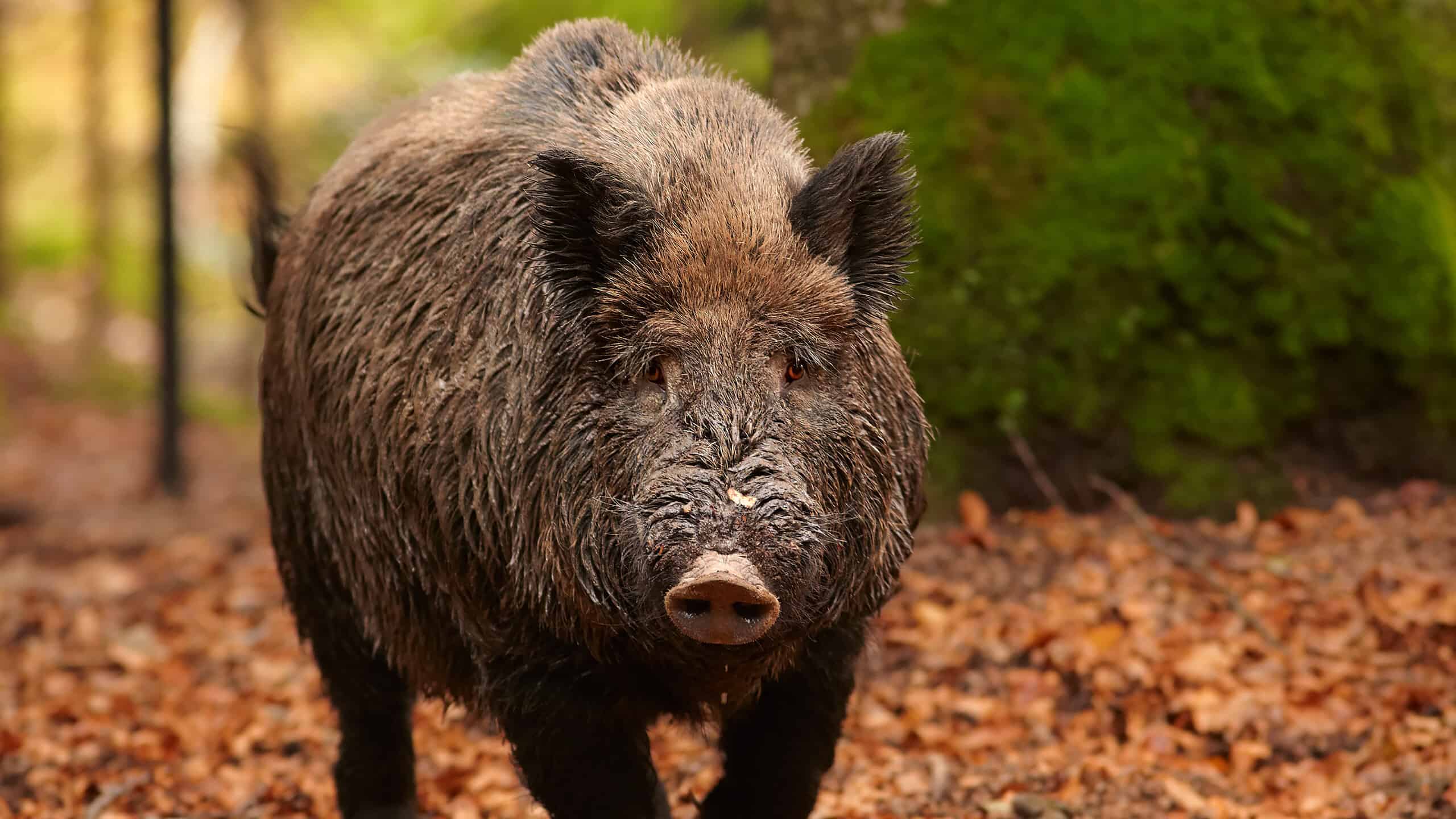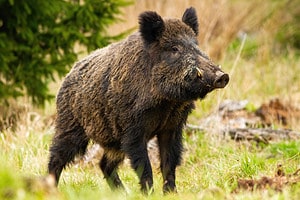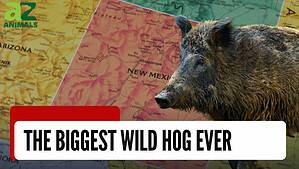The wild boar may have little to offer if we focus on looks. It’s also not an animal you’d want to bump into in the wild, as they can be dangerous. This mighty feral pig is muscular, replete with thick, bristly black or brown hair. The broad head, disc-shaped nose, beady eyes, pointy ears, and elongated canine give the wild boar a distinct look. But, avid South Carolina hunters do not care too much about the aesthetics of the wild hog. The feral pig provides one of the area’s favorite pastimes; hog hunting. It is a sport that does not have seasonal limitations. Before loading your rifle, learn more about the wild boars in South Carolina, the population, and hunting rules.
South Carolina Wild Boars Population
The United States has a large population of wild boars, running into millions. Data places the numbers at about 9 million in 40 States.
Texas leads the pack with 3 million wild hogs. Other states with sizeable wild boar populations include Oklahoma, Louisiana, Georgia, and Florida. Others are California, Hawaii, and Alabama.
South Carolina also has a massive wild boar population of about 450,000. There has been a dramatic population increase within the last decades.

The United States has a large population of wild boars, running into millions.
©Ondrej Prosicky/Shutterstock.com
Why the High Wild Hog Population?
Several reasons contribute to the increase in wild hog populations in South Carolina. Here’s a detailed look at each of these factors:
The Adaptability of the Wild Hog to Any Environment
If you compare the wild hog to any other animal, it would be the cockroach. These animals are resilient and will quickly adapt to any habitat. Wild hogs prefer dense vegetation, swampy areas, or anywhere near water. Furthermore, you’ll also find feral hogs in mountain ranges and regions experiencing sub-zero temperatures.
Wild Boars Can Eat Almost Anything
Wild boars can quickly adapt and multiply because of their diet. These non-picky omnivores can consume plants and animals in equal measure.
Top of their list are acorns and hickory nuts. Aside from that, they will also eat snakes, fungi, insects, tree bucks, and roots. Throw in some carrion, newborn livestock, manure, and eggs; the wild boars will be good to go.
Wild Hogs Are Prolific Breeders
Here is another interesting fact about these feral pigs. The females can start breeding even before they reach six months of age. As long as they achieve about 25kg in weight, the females can start producing a litter of piglets.
Each sow can produce two litters, containing up to ten piglets yearly. The wild hog population can also double in under four months under ideal conditions.
Wild Boars Are Intelligent Creatures
The wild boar is a fascinating creature — it’s intelligent and will quickly learn human behavior. Moreover, the hogs can easily evade hunters, which could explain why avid hunters find them a thrilling challenge.
During peak hunting seasons, the wild hogs will stay out of sight during the day and only feed at night. Hiding in dense vegetation or water sources makes them very difficult to locate. With their hyper-developed sense of smell and hearing, you have a vigilant, dangerous animal.
Wild Boars Learn From Past Experiences
Wild boars are a living example of machine learning. These feral hogs learn from past experiences and will change their behavior accordingly. For instance, the boars can associate human scents or rifle sounds with danger and move away.
If the wild hogs feel cornered, they can display very aggressive behavior. Their canines, which are what many call tusks, are formidable tools. That is why you want to avoid bumping into one on your walks in the neighborhood.
Human Activity Adds to the Population Increase
Humans are also to blame for the dramatic increase in the wild boar population. Some people release domestic pigs into the wild either intentionally or accidentally. The released pigs interbreed and bring forth hybrid offspring. The hog offspring are hardy and can comfortably survive and reproduce in the wild.
The Western Hemisphere is not the native home to boars. Their presence in these regions is attributable to human introduction. Some people will even transport wild hogs to specific areas for hunting purposes.
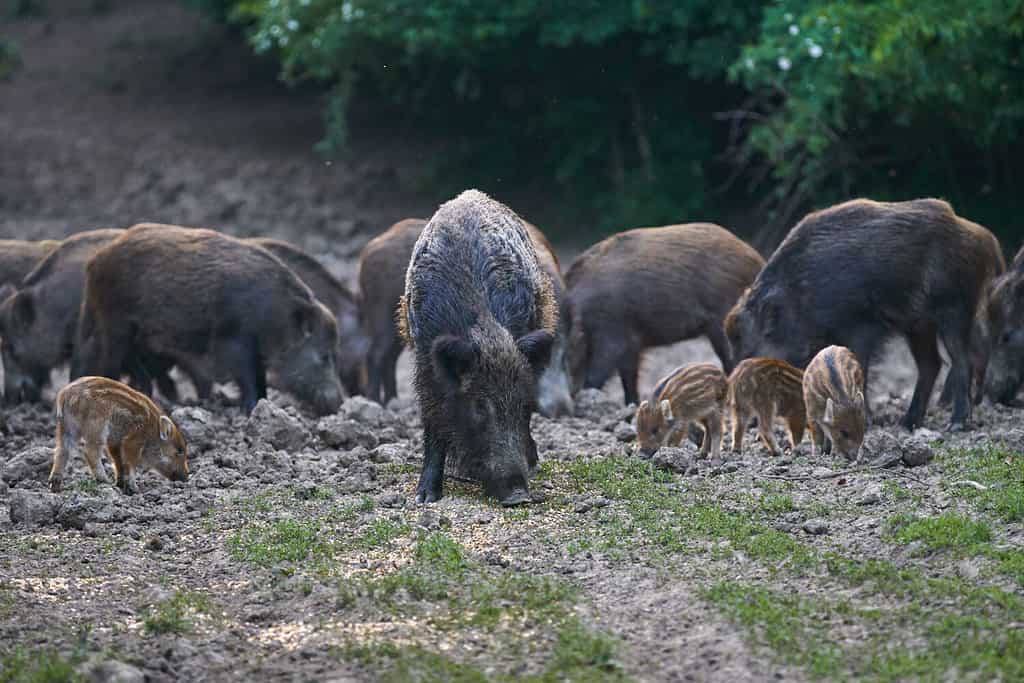
Wild hogs are very prolific. Each sow can produce two litters, containing up to ten piglets yearly.
©Slatan/Shutterstock.com
Challenges of the Increasing Wild Hog Population
The increasing wild hog population comes with many issues. Such include:
- The invasive hogs destroy natural, developed, and agricultural landscapes. The damage they cause could run into tens of millions of dollars.
- Impact of the feral pigs on the livestock industry due to the spread of zoonotic diseases.
- Threat to human life. The aggressive creatures can attack if they feel your presence poses a danger.
- Spread of diseases like swine brucellosis to humans. The disease can be debilitating and has long-lasting effects.
Why Wild Boar Hunting Is So Popular in South Carolina
The reasons why many people gravitate towards the sport are numerous, including the following.
Wild Boar Hunting Provides the Ultimate Challenge
Hunting a wild boar is a thrilling and challenging pursuit. You will test your mettle against intelligent, aggressive, and strong animals. The hog’s keen sense of smell and hearing will require the utmost patience and skill to get close to them.
The best time to hunt for wild boards is winter or fall months. At that time, food sources are scarce, and they’ll be more visible as they scavenge for food.
Passing Down Family Traditions
Hunting wild boars is a generational tradition for many communities and families. The older generation gets a chance to teach the younger people hunting skills.
Wild Boar Hunting Contributes to Conservation Efforts
Wild boar hunting has been a critical tool in conservation efforts. The animals are invasive, destructive, and multiply at very high levels. Thus, hunting helps with keeping the populations in check.
Hunting Wild Boars as Recreational Activities
Hunting provides a fantastic way to embrace and enjoy nature away from daily stressors. Wild boar Hunting offers an exciting and unique experience that may include tracking, gunning, or bow hunting. Most individuals interested in wild boar hunting would engage in a guided hunt. This can be done on either public land or private ranches, depending on the regulations and laws of the state.
The Social Aspect of Wild Boar Hunting
Wild boar hunting is excellent when you do it with family and friends who enjoy the sport. And there is always the chance for new connections when you bump into other hunters. That could be the beginning of lifelong friendships honed over a wild boar hunting expedition.
Wild Boar Meat Is Delicious
When you look at the wild boar, you may not think about eating it. However, wild boar meat is delicious and has been a part of the human diet for centuries. Any chef or hunter with some culinary skills will tell you that wild boar is one of the most delicious meats out there.
Wild boar meat tastes a lot like regular pork, is tender, juicy, and can be cooked in various ways. Wild Boar meat is also low in fat, high in protein, and very healthy for you. This makes it an excellent option for people who want to lead a healthier lifestyle or add something new to their regular diet.
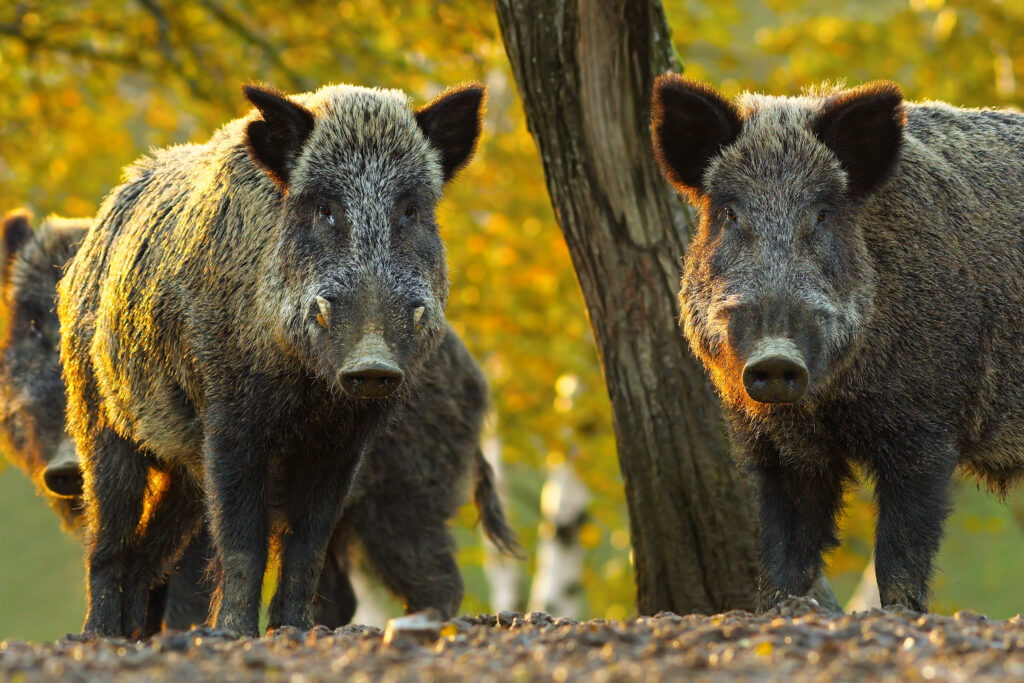
Wild boar hunting has been a critical tool in conservation efforts. The animals are invasive, destructive, and multiply at very high levels.
©iStock.com/taviphoto
Hunting Wild Boars in South Carolina: Rules to Be Aware Of
The SCDNR, or the South Carolina Department of Natural Resources, regulates the hunting of wild boars in South Carolina.
Wild boar hunting occurs on private or public land. This is important to note, as different rules govern each location. You’ll better understand this as we delve into the hog hunting rules in South Carolina.
Wild Boar Hunting License Requirement
A valid South Carolina hunting license is necessary to hunt wild boars. You’ll need to apply for one from the SCDNR.
But that’s not all. There are applicable permits, stamps, and tags that will also be required. The latter will typically depend on the time of year and the location of the hunt. Ensure to comply with the licensing regulations. Violating these hunting rules is a misdemeanor. It could result in penalties of up to $500 or imprisonment of up to 30 days.
Wild Boar Trapping on Private Land
The license requirement does not apply to trapping hogs on private land. It’s also worth noting that you cannot use cable restraints or snare traps to do the job. This is because other wildlife, such as bears or deer, should be able to escape the trap without any injuries.
Age Requirements
Any hunter who is 16 years and above must have a valid hunting license. Additionally, all hunters born after 30th June 1979 must complete an SCDNR-approved hunter education course first. This applies to both South Carolina residents and non-residents.
Night Hunting
The SCDNR allows for the night hunting of feral hogs on registered properties.
If you want to hunt on any unregistered property at night, you must have a DNR-issued depredation permit.
The Department requires annual reports for any night hunting activities. You will need these for the annual re-registration of the hunting properties. Remember that South Carolina does not allow wild hog hunting on wildlife management area (WMA) land at night.
Yardage Restrictions for Night Hunting
The law does not permit hunting feral hogs within 300 yards of a residence. However, this does not apply to hunting in registered hunting properties. If the homeowner or occupants permit you, then the 300-yard restriction does not apply. The same applies if you have an SCDNR depredation permit. Also, do not attempt to shoot the animals on, from, or across public paved roads.
Hunting Equipment
When hog hunting on private land, there are no weapon restrictions. Hunters can use night vision devices, artificial light, legal firearms, bows, and crossbows. In WMAs, you can only use the current open-season weapons. Take the case of deer hunting seasons as an example. At this time, archery equipment is the one most in use. That means you have to stick to the same when hunting hogs.
Wild Hog Hunting With Dogs
There are no state restrictions for dog hunting on private land. Ensure you comply with the requirements under the property registration rules.
But on WMA land, there are limitations. Take note of the different zones and time rules. Hunters can, for instance, use dogs during special hunts. Also, handguns can be used at such times.
Visit the SCDNR website for more up-to-date information.
Southern Carolina Wild Boar Hunting Seasons
There is no limit to when you can hunt at any time of the year on registered or private land.
On public land, there are designated seasons. The hunting dates may vary depending on the WMA, heritage preserves, or National forest calendar.
Check with the SCDNR for up-to-date information, depending on when you want to hunt. The area managing agencies can also provide the necessary information.
Bag Limits
The bag limit refers to the number of animals you can legally harvest or ‘bag’ during the hunting expedition. Bag limits are critical for ensuring sustainability by preventing the overharvesting of a specific animal species.
Since wild boars do not enjoy state protection in Southern Carolina, there is no bag limit. But, you must report your harvest to the SCDNR within 24 hours. The Department requires information for population tracking and establishing hunting rules.
Hog Transportation
As of 2021, the Federal Hog Transportation Bill came into law. This law was designed to ensure that hogs are transported in the most humane way possible. Here’s what’s included in the law:
- Prosecution for the illegal movement of feral hogs.
- Transportation of wild hogs when alive is forbidden.
- Animals must be correctly identified, or the SCDNR can destroy or seize them. Hunters may also be liable for fines of up to $1,000 for every animal and possible imprisonment.
Hunters can apply for a license from an approved state veterinarian. The document must clearly outline the quantity and source of the animals. The state assumes that any animal lacking proper identification is from the wild, thus a violation of the laws.
Across the State Line Transportation
You must get a USDA-approved inspection of the wild hog carcass to transport it across the state lines. The other requirement is proper storage of the dead hog at temperatures of or below 40 degrees Fahrenheit. You’ll also need a game-transporting license if you’re transporting live animals instead. Additionally, when transporting squirrels or birds across state lines, you must have them in cages and secured with locks.
Carcass Disposal
You’ve cut out the best parts of the wild hog and need to decide what to do with the carcass. As tempting as it is to dispose of it in the woods, you should be aware of regulations concerning the disposal of game animals. In most states, burying or abandoning animal carcasses on public land is illegal, and many private landowners won’t allow it either.
Disposing of the carcass in the right way is the best option. Rendering facilities or approved landfills are the most common options. Most rendering facilities will accept wild game carcasses, though they may charge a fee. Alternatively, you can check with local landfills to see if they have specially designated areas for the disposal of animal carcasses. If all else fails, contact your state wildlife or conservation agency for guidance and information on proper disposal methods in your area.
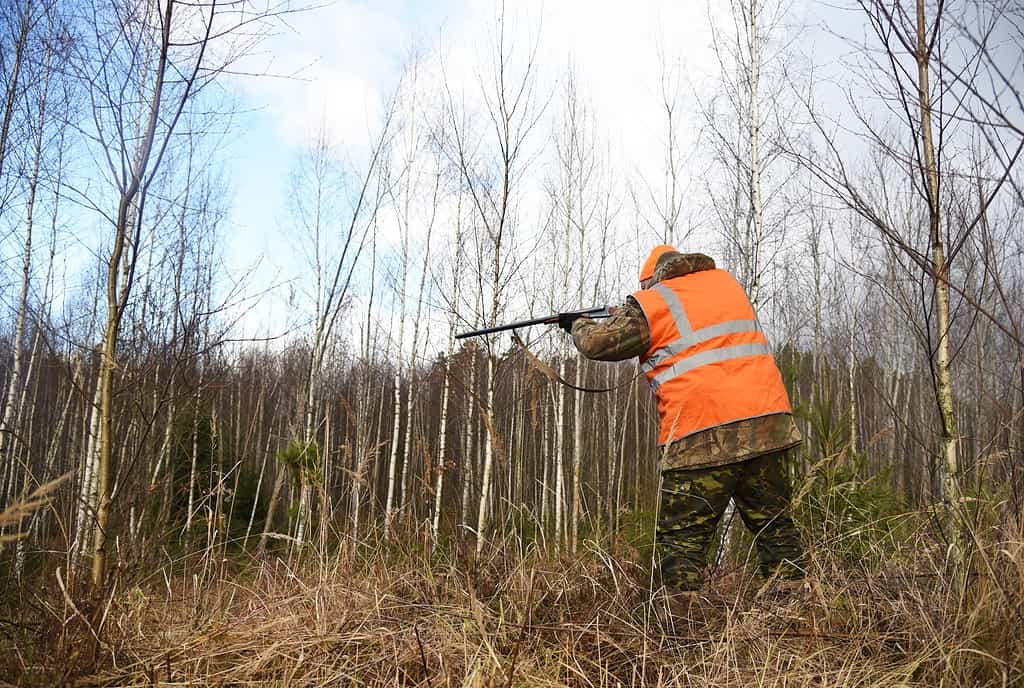
A valid South Carolina hunting license is necessary to hunt wild boars. You’ll need to apply for one from the SCDNR.
©Maksim Safaniuk/Shutterstock.com
Best Wild Boar Hunting Locations in South Carolina
As we shared, hunting wild boars is a favorite pastime in South Carolina. Some of the best hunting locations are in the upstate, midlands, and low-county regions.
Also, check out the Francis Marion and Sumter National Forests. The extensive plant coverage and varied habitat make the locations ideal for large families of wild hogs. You can apply for a hunting permit at the venues in both places.
Enjoy Your Wild Boar Hunting Adventure, But Stick to the Rules
That’s why it’s essential to follow the laws, regulations, and safety measures set by local and state game departments when planning a wild boar hunting adventure.
But aside from the thrill of the adventure, you can enjoy some pretty tasty cuts from your hunt. Wild boar meat is considered a delicacy in many cultures and regions. Its sweet, savory taste makes it a favorite among wild game enthusiasts.
Whatever your reasons for hunting wild boar, do your research and ensure you’re ready for the challenge. With some preparation and tools, you can have a safe and successful wild boar hunting experience.
Thank you for reading! Have some feedback for us? Contact the AZ Animals editorial team.

